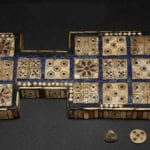 Movies and TV
Movies and TV  Movies and TV
Movies and TV  History
History 10 Things You Never Knew About Presidential First Ladies
 Movies and TV
Movies and TV 10 Zombie Movies That Will Actually Terrify You
 Humans
Humans 10 Times Scientists Were Absolutely Sure… and Absolutely Wrong
 Our World
Our World 10 Pivotal Moments for Life on Earth
 Movies and TV
Movies and TV 10 Most Realistic Medical TV Shows of All Time
 Creepy
Creepy 10 Eerie & Mysterious Ghosts of the Pacific Coast
 Weird Stuff
Weird Stuff 10 Typos That Accidentally Changed History
 History
History 10 Times Trickery Won Battles
 Technology
Technology 10 Awesome Upgrades to Common Household Items
 Movies and TV
Movies and TV 10 Movie Flops That Found Their Way to Cult Classic Status
 History
History 10 Things You Never Knew About Presidential First Ladies
 Movies and TV
Movies and TV 10 Zombie Movies That Will Actually Terrify You
Who's Behind Listverse?

Jamie Frater
Head Editor
Jamie founded Listverse due to an insatiable desire to share fascinating, obscure, and bizarre facts. He has been a guest speaker on numerous national radio and television stations and is a five time published author.
More About Us Humans
Humans 10 Times Scientists Were Absolutely Sure… and Absolutely Wrong
 Our World
Our World 10 Pivotal Moments for Life on Earth
 Movies and TV
Movies and TV 10 Most Realistic Medical TV Shows of All Time
 Creepy
Creepy 10 Eerie & Mysterious Ghosts of the Pacific Coast
 Weird Stuff
Weird Stuff 10 Typos That Accidentally Changed History
 History
History 10 Times Trickery Won Battles
 Technology
Technology 10 Awesome Upgrades to Common Household Items
10 Childhood Games and Activities That Became Competitive Sports
Before the numerous advancements in technology, such as computers, tablets, and smartphones, life seemed simple and carefree.
Children often spent their afternoons playing games outdoors, riding bicycles, and letting their imaginations run wild. The most basic toy or game provided hours of endless entertainment. Street lights meant it was time to go home, and some of the best memories were made with our friends on the playground.
This list contains 10 childhood games and activities that became competitive (and in some cases professional) sports.
Related: 10 Ancient Board Games That Inspired Modern Games
10 Tag
The game of tag is based on a simple premise—one player is chosen to be “it,” and their goal is to chase and tag someone else who will then become “it.” From there, the game continues as players try to evade being tagged. In some instances, there may also be a “safe space” or designated item to hold that gives the other players immunity from being tagged or becoming “it.”While other versions of the game, such as freeze tag and shadow tag, have emerged over time, the basic concept remains the same.
However, in 2012, brothers Christian and Damien Deveaux of the United Kingdom took the game to a new level. Thanks to their clever innovation, this simple childhood game was revamped and has now become a professional sport known as World Chase Tag, in which both men and women from around the world compete.
World Chase Tag has a team format comprised of two teams with up to six players each, where the players compete in matches. Each match consists of 16 “chases” that are 20 seconds long. In a chase, one competitor from each team battles against the other in a 40-by-40-foot (12-by-12-meter) quad full of obstacles, ramps, and platforms. One competitor will be deemed the “Chaser” and the other the “Evader.”
Once the chase begins, the chaser has a mere 20 seconds to tag his opponent only using his hands. If the chaser successfully tags his opponent, the chase is over, and the chaser’s team is awarded a point. In this case, the chaser then becomes the evader in the next chase. However, if the evader is able to escape capture during the 20-second match, their team gets a point.
Players are given a 25-second rest between chases, and once all 16 chases of the match have been completed, the team with the most points wins.[1]
9 Dodgeball
Another game that seemed to always be present either on the playground or in gym class was dodgeball. However, this childhood game is a bit more brutal than tag, especially if you were not particularly athletic or popular among your peers, making you much more of a target. Although not the most pleasant game at times, it was still far better than its original African version in which rocks were hurled at other players and then later used to “finish them off” once they had fallen down.
Regardless of the brutal premise of a game that uses human targets, there are still plenty of people who love dodgeball, and in 2004 the National Dodgeball League was established in the United States. Then, in 2011, the Worldwide Dodgeball Federation was formed.
Many of the rules in professional dodgeball remain the same as the game children play—two teams compete against each other, hitting the opposing players with dodgeballs to take them out of the game. However, there are a few variations that make the game a bit more organized and less painful for the players.
Professional dodgeball teams have a minimum of six players and a maximum of 12. Each team is also allowed to have up to three designated ball retrievers and two team leaders. Teams play matches against each other, consisting of two 20-minute halves with a five-minute break in between.
Rather than using the school gym or a makeshift field on the playground, the playing court in professional dodgeball is a flat rectangular area measuring 59 feet (18 meters) long and 29 feet (9 meters) wide. The playing area not only contains the actual playing court but a free space, a queue area, and a penalty and substitution area. Additionally, there are barriers surrounding the area to ensure the balls stay within the playing field.
Additionally, rather than being pelted by the horrible rubber balls that leave behind welts, professional dodgeball players use either cloth or foam balls in their games. However, when cloth balls are used, the game will be played with five balls, whereas when using the foam option, the game will consist of six balls.[2]
8 Musical Chairs
The game of musical chairs is simple, fun, and requires nothing more than chairs and some music, making it a perfect choice for children’s birthday parties or family get-togethers.
Chairs are placed in a circle using one less chair than the number of players, and once the music starts, players will walk around the circle. When the music stops, the rush to sit in a chair begins, and the player without a seat is eliminated. The game will continue in this fashion, removing one chair after each round until there is a winner. While there is definitely a competitive edge to this childhood game, it became a yearly championship with a large grand prize.
In 2011, 32-year-old Fred Smith, a former prison guard, began working for a company that produced large-scale events such as scavenger hunts. When a friend contacted Smith for fundraising ideas, he immediately thought about a large-scale championship game of musical chairs. Thus, in 2012, the World Musical Chairs Federation was born, and the first championship game was held in Amesbury, Massachusetts.
Given the competitive nature of the game, and Smith’s time as a prison guard, he set out to create a set of rules to ensure fair gameplay and no overaggression from the players. Therefore, in the Musical Chairs World Championship games, once the music stops, players have only seven seconds to sit in a chair (butt first) and cannot use any other body parts to force their way into a seat.
Additionally, Smith asks players to provide an emergency medical contact in the event of an injury and also enlists one referee for every 40 players, along with two dozen “enforcers” to keep the game safe for all players. In 2012, the winner received a $10,000 prize.[3]
7 Speedcubing
In 1974, Hungarian architect Ernő Rubik created the Rubik’s cube, although originally, it was called the “Bűvös kocka,” or Magic Cube. While its outside appearance seems simple—nine colored squares of red, yellow, green, blue, orange, or white on each side—solving the puzzle and returning the cubes to their original state is a difficult challenge. Given the 43 quintillion variations to solving the cube, it took Rubik himself over one month to solve the puzzle he created.
Regardless of Rubik’s belief in his cube, he was told that no one would want to play with it because it didn’t look like a “toy.” While he tried selling the cube in Hungarian toy shops from 1977-1979, it wasn’t until 1980 that Rubik partnered with the Ideal Toy Company to bring it to America and distribute it globally. It was then that the name was changed to the Rubik’s cube, and to date, over 450 million cubes have been sold.
Today, speedcubing has become a competitive sport in which participants try to solve cube puzzles as quickly as possible. Typically, the traditional 3×3 cube is used, but there are also more elaborate versions of the cube, some as large as 7×7. The current world record for solving a 3×3 cube is held by 22-year-old Yusheng Du of China after solving the cube in just 3.47 seconds.[4]
6 Four Square
Another seemingly simple playground game was foursquare. All that was required was a piece of chalk or even a stick, an area large enough to draw the four squares, and a ball.
The playing area is divided into four quadrants numbered 1-4. In somewhat of a mix between dodgeball and volleyball, players take turns serving the ball into another player’s square. If that player is unable to serve the ball to another player after one bounce, or if it hits a line or goes out of bounds, they are eliminated, and someone else will take their place. Additionally, each time a player is eliminated, everyone else moves to the next numbered square with the goal of reaching the highest rank—4.
This playground pastime is now part of a yearly championship thanks to Peter Lowell, who started the first Four Square World Championship in 2010. The championship game is held in Bridgeton, Maine, as a fundraiser for the Lakes Environmental Association and draws in people from all over the world.
However, unlike the playground version with no time constraints, the competition begins with an hour-long first round. From there, half of the players will advance to a 40-minute semi-final round, where eight players will then advance to a 25-minute final game. The player who is in the top-ranked square for the longest amount of time is deemed the winner.[5]
5 Marbles
The game of marbles dates back to ancient civilizations of the Greeks, Romans, Egyptians, and even some Native American tribes, although these games were typically played with stones, pieces of clay, or nuts.
Competitive marble tournaments have taken place since the early 1920s. For example, the National Marbles Tournament in Wildwood, New Jersey, was founded in 1922 and provides an opportunity for children from the ages of 7-14 to compete in a four-day tournament that awards college scholarships. The tournament is held each year a week after Father’s Day at Ringer Stadium off the beach boardwalk.
Additionally, The British and World Marbles Championship formally began in 1932 and is held every year on Good Friday at the Greyhound Pub in Tinsley Green, Sussex.[6]
4 Nerf Gun Battles
Lonnie Johnson worked as a research engineer, was a member of the U.S. Air Force, and also worked as a system engineer for NASA on the Galileo mission to Jupiter, the Mars Observer Project, and the Cassini mission to Saturn. He is also the man responsible for creating the Super Soaker and the Nerf soft foam dart guns.
Being made out of foam, nerf guns provided an exciting war-themed option for play that was safe enough to be done indoors and without the worry of bodily injury. However, in 2016, Jared Guynes of Dallas, Texas, decided to take these blaster battles to the extreme.
Guynes created Jared’s Epic Blaster Battle, and the first battle took place on March 12, 2016, at AT&T Stadium in Arlington, Texas, with 2,289 participants. It also earned Guynes a world record for the largest toy pistol fight. The event made $14,000 in profit from ticket sales which Guynes donated to tornado relief efforts.
Aside from the battle at the Dallas Cowboys’ stadium, Guynes has now taken his event on the road and is hosting other blaster battles at SoFi Stadium in Inglewood, California, and the Atlanta Falcons Mercedes-Benz Stadium in Atlanta, Georgia.[7]
3 Red Rover
To play the game of Red Rover, players are divided into two equal teams, and each team decides on a captain. The players on each team then link hands to form a “chain” and face their opposing teammates.
One team captain will choose a player from the opposite team and shout, “Red Rover, Red Rover, send (player’s name) over!” The chosen player will try to run and break through the opposing team’s chain. If they are successful, they choose a player to take back to their team. However, if they fail to break through, they must remain with the opposing team. A winner is determined when one of the teams has only one player left.
Kabaddi was established as a professional sport in 2014 and is a mix of the playground game Red Rover along with a few elements of tag, rugby, and touch football. The word kabaddi was derived from the word “kai-pidi” in the Tamil language, which means “to hold hands.” Like the game Red Rover, kabaddi is simple in its premise and requires no special equipment.
Two teams consisting of seven players each will line up on a 42.6 x 32.8-foot ( 13 x 10-meter) hard rubber mat facing one another. The mat is separated by a midline, and each team will hold hands, forming a defense chain. One team will send out a “raider” whose goal is to run and tag as many opposing team members as possible within 30 seconds, all while chanting “kabaddi” repeatedly before making it back to their side of the mat without being tackled by the opposing defense. The opposing team will then send out their “raider.” The match will continue in this fashion for two 20-minute halves, giving the players a five-minute break between halves.[8]
2 Board Games
The game of Go (also referred to as weiqi in Chinese or baduk in Korean) is believed to be the world’s oldest board game, with origins in China dating back approximately 4,000 years ago. In ancient China, the game was also considered one of the “Four Accomplishments” a gentleman must master, along with playing the lute, writing calligraphy, and painting.
Go is a two-player board game consisting of a wooden board with grids and black and white stones. The player using the black stones goes first, and players take turns placing stones on the board on intersecting lines with the goal of trying to surround their opponent’s stones. Final scores are calculated based on the total number of points earned for capturing your opponent’s stones minus the number of stones lost to the opponent. The player with the most points wins.
There are several associations and federations for professional players, such as the Japanese Go Association, the European Go Federation, the International Go Federation, and the American Go Federation. There are also various competitive tournaments held all over the world as well as an online version of the game called AlphaGo for those who want to learn how to play.[9]
1 Hide and Seek
The world’s only large-scale international competition of hide and seek began in 2010—the Nascondino World Championship in Consonno, Italy. The town was once considered the “Las Vegas of Italy,” but it was devastated by a landslide in 1976, and today, the village is nothing more than a ghost town.
However, the two-day competition in September brought the town to life as 80 teams composed of players from nearly a dozen different countries worldwide participated in the 2017 competition.
Teams consist of five people, and one player from each team hides. Players are then given 60 seconds to find a hiding spot before the seekers are sent out. Players may choose to hide behind hay bales that have been set out on the field or other obstacles; however, they are not allowed to hide in any of the abandoned buildings.
Players are then given 10 minutes to get from their hiding spot and reach home base (a large air mattress) before being caught by a seeker. The player that reaches home base first is awarded 20 points, the second player reaching home base receives 19 points, the third player gets 18 points, and so on. The 20 teams with the most points will compete in a final game where the winning team receives a golden fig leaf.[10]








